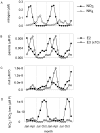Modeling selective pressures on phytoplankton in the global ocean
- PMID: 20224766
- PMCID: PMC2835739
- DOI: 10.1371/journal.pone.0009569
Modeling selective pressures on phytoplankton in the global ocean
Abstract
Our view of marine microbes is transforming, as culture-independent methods facilitate rapid characterization of microbial diversity. It is difficult to assimilate this information into our understanding of marine microbe ecology and evolution, because their distributions, traits, and genomes are shaped by forces that are complex and dynamic. Here we incorporate diverse forces--physical, biogeochemical, ecological, and mutational--into a global ocean model to study selective pressures on a simple trait in a widely distributed lineage of picophytoplankton: the nitrogen use abilities of Synechococcus and Prochlorococcus cyanobacteria. Some Prochlorococcus ecotypes have lost the ability to use nitrate, whereas their close relatives, marine Synechococcus, typically retain it. We impose mutations for the loss of nitrogen use abilities in modeled picophytoplankton, and ask: in which parts of the ocean are mutants most disadvantaged by losing the ability to use nitrate, and in which parts are they least disadvantaged? Our model predicts that this selective disadvantage is smallest for picophytoplankton that live in tropical regions where Prochlorococcus are abundant in the real ocean. Conversely, the selective disadvantage of losing the ability to use nitrate is larger for modeled picophytoplankton that live at higher latitudes, where Synechococcus are abundant. In regions where we expect Prochlorococcus and Synechococcus populations to cycle seasonally in the real ocean, we find that model ecotypes with seasonal population dynamics similar to Prochlorococcus are less disadvantaged by losing the ability to use nitrate than model ecotypes with seasonal population dynamics similar to Synechococcus. The model predictions for the selective advantage associated with nitrate use are broadly consistent with the distribution of this ability among marine picocyanobacteria, and at finer scales, can provide insights into interactions between temporally varying ocean processes and selective pressures that may be difficult or impossible to study by other means. More generally, and perhaps more importantly, this study introduces an approach for testing hypotheses about the processes that underlie genetic variation among marine microbes, embedded in the dynamic physical, chemical, and biological forces that generate and shape this diversity.
Conflict of interest statement
Figures




Similar articles
-
Diversity of Synechococcus and Prochlorococcus populations determined from DNA sequences of the N-regulatory gene ntcA.Environ Microbiol. 2006 Jul;8(7):1200-11. doi: 10.1111/j.1462-2920.2006.01010.x. Environ Microbiol. 2006. PMID: 16817928
-
Genomic potential for nitrogen assimilation in uncultivated members of Prochlorococcus from an anoxic marine zone.ISME J. 2015 May;9(5):1264-7. doi: 10.1038/ismej.2015.21. Epub 2015 Feb 20. ISME J. 2015. PMID: 25700337 Free PMC article.
-
Widespread metabolic potential for nitrite and nitrate assimilation among Prochlorococcus ecotypes.Proc Natl Acad Sci U S A. 2009 Jun 30;106(26):10787-92. doi: 10.1073/pnas.0902532106. Epub 2009 Jun 23. Proc Natl Acad Sci U S A. 2009. PMID: 19549842 Free PMC article.
-
Long-term oceanographic and ecological research in the Western English Channel.Adv Mar Biol. 2005;47:1-105. doi: 10.1016/S0065-2881(04)47001-1. Adv Mar Biol. 2005. PMID: 15596166 Review.
-
Prochlorococcus: advantages and limits of minimalism.Ann Rev Mar Sci. 2010;2:305-31. doi: 10.1146/annurev-marine-120308-081034. Ann Rev Mar Sci. 2010. PMID: 21141667 Review.
Cited by
-
The infinitely many genes model for the distributed genome of bacteria.Genome Biol Evol. 2012;4(4):443-56. doi: 10.1093/gbe/evs016. Epub 2012 Feb 21. Genome Biol Evol. 2012. PMID: 22357598 Free PMC article.
-
Upward nitrate transport by phytoplankton in oceanic waters: balancing nutrient budgets in oligotrophic seas.PeerJ. 2014 Mar 13;2:e302. doi: 10.7717/peerj.302. eCollection 2014. PeerJ. 2014. PMID: 24688877 Free PMC article.
-
Glutamine Synthetase Sensitivity to Oxidative Modification during Nutrient Starvation in Prochlorococcus marinus PCC 9511.PLoS One. 2015 Aug 13;10(8):e0135322. doi: 10.1371/journal.pone.0135322. eCollection 2015. PLoS One. 2015. PMID: 26270653 Free PMC article.
-
Physiology and evolution of nitrate acquisition in Prochlorococcus.ISME J. 2015 May;9(5):1195-207. doi: 10.1038/ismej.2014.211. Epub 2014 Oct 28. ISME J. 2015. PMID: 25350156 Free PMC article.
-
A holistic approach to marine eco-systems biology.PLoS Biol. 2011 Oct;9(10):e1001177. doi: 10.1371/journal.pbio.1001177. Epub 2011 Oct 18. PLoS Biol. 2011. PMID: 22028628 Free PMC article.
References
-
- Tilman D, Kilham SS, Kilham P. Phytoplankton community ecology: the role of limiting nutrients. Annu Rev Ecol Syst. 1982;13:349–372.
-
- Dugdale RC. Nutrient limitation in the sea: dynamics, identification and significance. Limnol Oceanogr. 1967;12:685–695.
-
- Cooper VS, Lenski RE. The population genetics of ecological specialization in evolving Escherichia coli populations. Nature. 2000;407:736–739. - PubMed
-
- Maynard-Smith J, Haigh J. The hitchhiking effect of a favorable gene. Genet Res. 1974;23:23–35. - PubMed
Publication types
MeSH terms
Substances
LinkOut - more resources
Full Text Sources

